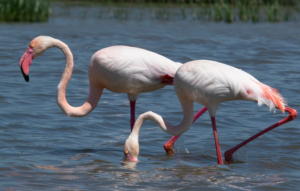Lesser Flamingos in Uganda
Lesser Flamingos in Uganda : These are generally the smallest of all flamingos, however, has the largest number of population. It is among the unique bird species explored by birders on safari in Uganda. These birds are Palearctic migrants arriving in October and departing in April. Thousands of these birds roost at the lake because it’s safe for them as at one stage of the year it turns muddy. In fact, it makes it difficult for wild animals to wade through the mud and prey on them.
Facts about the Lesser Flamingos
Appearance
It has rich pink plumage, with a long neck, yellow eyes and long pink legs. While in flight, the crimson red and black narrow wings are highly conspicuous. These are occasionally visible when the bird is on the ground. On the other hand, the bill is maroon with a black tip.
Diet
The Lesser, James and Andean flamingos have deep-keeled bills and mostly eat blue green algae and diatoms. However, they occasionally eat crustaceans and small insects. Besides, Greater and Chilean flamingos have shallow-keeled bills and feed on insects, aquatic invertebrates and small fish. However, Caribbean flamingos eat larval and pupal forms of flies and brine shrimp as their main food.
 Breeding
Breeding
Lesser flamingo individuals do not breed annually but each individual breeds every 5 to 8 years. In fact, their breeding time typically takes place between October and February. Besides, they typically lay one egg per clutch but occasionally two eggs are produced. In Africa where they are most numerous, they breed principally on the highly caustic Lake Natron in northern Tanzania. Interestingly, they live up to 50 years in the wild.
Habitat
These birds generally inhabit coastal and inland wetlands of sub-Saharan Africa and India. They breed on large alkaline and saline lakes, salt pans and coastal lagoon. These graceful birds prefer saltwater habitats including saline or alkaline lakes, estuaries, coastal lagoons & mudflats. Although they drink fresh water and are great swimmers they don’t often congregate in it.
Behavior
Flamingos spend most of the day feeding, preening, resting and bathing. Non-breeding birds feed at night and spend the day sleeping or involved in activities such as preening and bathing. However, in 1993 lesser flamingos are found to display aggressive behavior during courtship and mating.
Where to find them
In Uganda, the lesser flamingos are found in Queen Elizabeth National park at Lake Munyanyange in Katwe area. Lake Munyanyange attracts birds that migrate from as far as Kenya and Canada among other countries. The lake attracts birds such as; Lesser Flamingos, the White Browed Robbin Chats, Black Headed Gonoleks, Long Tailed Starlings, African Hoopoes, etc.






